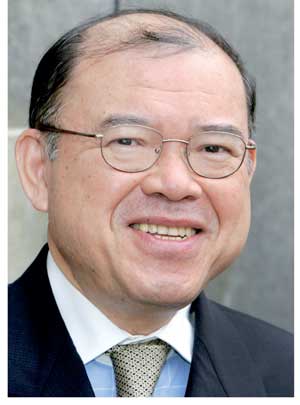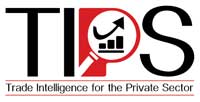28 Sep 2017 - {{hitsCtrl.values.hits}}
 By Anushka Wijesinha
By Anushka Wijesinha
Dr. Supachai Panitchpakdi has held many top roles in international trade organisations, from Secretary General of the United Nations Conference on Trade and Development (UNCTAD) to the World Trade Organisation (WTO) Director General and has an unparalleled aerial perspective of the global trade arena.
It was a privilege to have interviewed him during his visit to Sri Lanka last week, where we discussed global trade governance, future of Asian integration, prospects for Sri Lanka in its new outward orientation and whether the anti-globalisation rhetoric is here to stay. This special edition article, marking the 25th edition of the TIPS column series, reproduces the interview in full.
Dr. Panitchpakdi, what are some of the trends that have shaped trade in Asia in recent years and what are some of the ongoing changes?
Asia has actually greatly benefited from the time of the beginning of the 1990s and the beginning of the new millennium, when global trade was really progressing nicely, with average global trade volume growing at a rate of 6 to 7 percent per year. But since the great recession in 2008, the Asian economies had to restructure themselves in a way that they cannot always rely on external trade as a major strategy anymore. Although I must say from the outset that while we are searching for a rebalancing strategy between the domestic demand and external demand, my belief is still that, modern economies can only progress the engineered transfer of technology, deepen the international network of production only by means of unconstrained global trade. So, out of the crisis Asian economies have actually become more circumspect with their own financial system, strengthening the supervision framework and at the same time have better diversification of trade. Many East Asian economies have become net trade surplus economies and amassed massive amount of reserves. So this is a recap of what happened in Asia and the post mortem on the crisis in Asia.
Now, the second point is that because of the need to remodel our development strategy, Asian economies these days are turning towards strengthening the supply chain but at the same time trying to do it through more integration of economies within Asia. We did a study some time ago at UNCTAD and we found out that the new mode of trade has been influenced by intra-firm trade and this was particularly evolved by the Asian economies. Seventy percent of the new global supply chain has been originating in Asia. One of the specific characteristics of the new millennium trade scene in Asia is the kind of binding together of the international production chain in the region. The chain has actually gone through some metamorphosis. It used to be directed from the hub in China but now we see these different ladders in the chain are being moved around in Asia. It used to be Japan moved to Taiwan, China and Korea and now it’s in Thailand, it’s in Indonesia, it’s in the Philippines, it’s in Vietnam. Korea moved to Vietnam, Japan moved to Indonesia, China moved to Cambodia, Laos and Thailand. So it has become, I would say, a more advance step of supply chain with the countries that used to be at the receiving end of the FDIs are now becoming the provider of investments themselves.
China is increasingly becoming a key player of this new regional FDI trend, isn’t it?
I think in some years the Chinese external investments, outbound investments, tend to surpass inbound investment and this is going to be the trend as China is graduating from an export-oriented economy into one which is more balanced between the domestic demand and external demand. So, China’s metamorphosis at the moment is gaining ground. China before the crisis in 2008 had a huge excess of productive capacity, a huge excess. That’s why they had to depend on export and now it has been reduced and they have reoriented their economies towards more service industry. So China’s services economy has gone from 20 percent of GDP, now approaching 45 percent and soon it’ll be more than 50 percent. Rest of ASEAN is also going to services; we are around 50 to 60 percent services industry in ASEAN and this is going to be the new path for trade in Asia which is not only supply chain in manufacturing but the services industries are going to help to deepen the chain, to make the supply chain more efficient because of better infrastructure, better logistics, better reaction to the consumer market and things like that. You can see also Thailand investing more in surrounding areas in the CLMV countries Cambodia, Laos, Myanmar and Vietnam. So does Malaysia, which is actually more committed to outbound investment than Thailand, stretching beyond just ASEAN into Africa and some parts of Europe as well.
‘‘The Belt and Road Initiative is actually the new model of regional integration that doesn’t have the kind of geographical limitation but stretches beyond different parts of the world linking Asia with Central Asia, East Asia with Central Asia and Europe to the land routes and maritime routes. For the Chinese, it’s double the benefit
In South Asia, we often look towards ASEAN and admire the substantial progress made on regional integration. What is the progress of, and prospects for, greater Asian integration?
Asian economies have become more conscious of the need to cushion themselves against the outside disruptive impacts. So you can see the size of the intra-Asian trade expanding. I think the latest figures from ADB should be around 50 to 51 percent of the intra-Asian trade to the total as a share of the total trade of Asia. This is second or third after the EU that has about 80 percent intra EU trade and NAFTA that is probably around 60 to 70 percent. In Africa or Latin America the shares would be below 20 percent. So, this is not really a new phenomenon. It has been going on but it’s going to be moving faster forward because of the speeding up of the supply chain. ASEAN has deepened this integration to the launch of the ASEAN Economic Community (AEC) that has not only liberalization in trade of merchandise goods, but also services, capital flows and also inflows of natural persons. So it’s more or less a complete economic area. The sub regional projects, which have always underpinned the ASEAN region, like the greater Mekong sub-region, the BIMSTEC, which links ASEANS Southeast Asia with South Asia, the so-called IMTGT – Indonesia, Malaysia, Thailand Growth Triangle. These sub regional undertakings have been helping to keep trade at the border level going on, supporting the new move towards more intra-Asian trade, providing for cushion against outside impacts.
What are your views on the TPP and its implications for Asia’s integration?
The Trans Pacific Partnership (TPP) was too much of a geopolitical move rather than a trade-promoting move, so I never thought highly of the TPP. I was a bit uncomfortable because of the fact that the TPP without the totality of ASEAN doesn’t mean much. It’s just the US with some of the countries that have common geopolitical interest. So I was very pleased when President Trump withdrew the US from the TPP. I am not against the trade content of the TPP, but the trade content of the TPP would have to have certain allowances like at the World Trade Organisation - some special and differential treatment so that you can take in the countries that cannot take up the US-centric trade arrangements. Countries like Cambodia, Laos, Myanmar even Vietnam actually could not do it but Vietnam – because of the geopolitical necessity – had to join. I thought the TPP at the moment is in a state of being stalled.
From the UN side, the Regional Comprehensive Economic Partnership (RCEP) is something that UN could easily support because it has a framework that doesn’t drift too far away from the WTO multilateral agreement. So I think the RCEP could be a bridge between the ASEAN Economic Community (AEC) and TPP. We need to wrap up negotiation on the RCEP as early as possible; it should be done this year but I was told  that India may be having second thoughts about being grouped together with China. But I think this is something necessary, to keep all this major countries together in this kind of a cooperation. The key idea in the RCEP is not about trade alone; it’s mainly development cooperation. I believe that countries like Sri Lanka could also make an effort to approach the RCEP; in a way it doesn’t have to be a full-fledged member but it can be an associate member. It can take on some of the requirements on a special and differential basis. I would think Sri Lanka would be able to enjoy the full benefit because Sri Lanka’s economic development is at much higher levels in terms of human resources, development, connectivity with the outside world and logistical support, probably better than in Myanmar, Cambodia and Laos. So it would be beneficial to allow Sri Lankan economy to join up with the RCEP.
that India may be having second thoughts about being grouped together with China. But I think this is something necessary, to keep all this major countries together in this kind of a cooperation. The key idea in the RCEP is not about trade alone; it’s mainly development cooperation. I believe that countries like Sri Lanka could also make an effort to approach the RCEP; in a way it doesn’t have to be a full-fledged member but it can be an associate member. It can take on some of the requirements on a special and differential basis. I would think Sri Lanka would be able to enjoy the full benefit because Sri Lanka’s economic development is at much higher levels in terms of human resources, development, connectivity with the outside world and logistical support, probably better than in Myanmar, Cambodia and Laos. So it would be beneficial to allow Sri Lankan economy to join up with the RCEP.
‘‘I believe that countries like Sri Lanka could also make an effort to approach the RCEP; in a way it doesn’t have to be a full-fledged member but it can be an associate member. It can take on some of the requirements on a special and differential basis
There is a rising rhetoric around anti-globalisation and questioning the benefits of freer global trade. What are your views on this? Should we be worried?
I have been reading articles around the world over the last few weeks and there is a lot of concern on the pushback against globalization. I don’t think this would be successful because globalization is not normally driven by what I call endogenous variables that can be influenced by trade policies from any individual economies. Globalization is more or less an exogenous process at the moment because the key factors impacting upon globalization is now being driven more by technological advances. You cannot hold back people travelling around the world at cheaper rates. Europe is now on the brink of negotiating Brexit, which to me will threaten the rest of Europe than it does with the UK economy. So, the UK will be more flexible in doing more FTAs with the rest of Asia and they are moving very quickly to do this with India, Australia, ASEAN and China. So I would say that the push back on globalization might produce some uncertainties in the trading scene; some re-emergence of non-tariff measures. But I don’t think there would be a turnaround in the process of globalization. The view at the UN is that we would like to see a new generation of globalization that should be development-led or development-centred globalization. Globalisation should take everyone on board, it should be inclusive globalization. It should be globalisation that is not driven by trade alone but also transfer of technology.
Finally, Dr. Paithcpakdi, what is your view on China’s new One Belt One Road Initiative?
The Belt and Road Initiative is actually the new model of regional integration that doesn’t have the kind of geographical limitation but stretches beyond different parts of the world linking Asia with Central Asia, East Asia with Central Asia and Europe to the land routes and maritime routes. For the Chinese, it’s double the benefit. Firstly, it transfers productive capacity outside of China to be invested outside China, so it helps to relive the tension inside China. Secondly, it helps pave the way for Chinese investment to come out to an area in which it was often quite uncertain in making investments in manufacturing as well as in logistics. And here again lies in which the Sri Lankan government could look at. So in a way to replicate what we’ve been doing in Southeast Asia with China in terms of getting involved in the supply chain, but to do this across Asia. Sri Lanka should position itself to be involved.

(Dr. Panitchpakdi is currently Chairperson of Central Pattana (part of the Central Group) in Thailand. He served as Deputy Prime Minister of Thailand, Secretary General of the UNCTAD from 2005 to 2013. Prior to this, he was Director General of the WTO 2002 to 2005. Anushka Wijesinha is Chief Economist at the Ceylon Chamber of Commerce. This article is part of the chamber’s ‘Trade Intelligence for the Private Sector’ (TIPS) initiative, where we bring our members fresh insights into global and national trade policy issues. Write to [email protected] to engage)
25 Nov 2024 17 minute ago
25 Nov 2024 1 hours ago
25 Nov 2024 1 hours ago
25 Nov 2024 3 hours ago
25 Nov 2024 4 hours ago